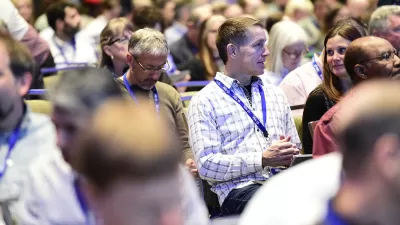We’ve all been subject to them – the endless powerpoint presentations that extol the worst aspects of animated text and mind-numbing bullet points. While Edward Tufte has written about the horrors of powerpoint, I see it as just a tool and like any tool it can be used wisely or poorly. After all, David Byrne, the former Talking Heads front man, makes art with powerpoint so it can’t be all bad. But one thing struck me at the American Planning Association’s (APA) conference two weeks ago: some sessions would have been much better if the powerpoint presentation (or abuse thereof) didn’t get in the way. In actuality, some of the best presentations I attended didn’t use powerpoint at all.
We've all been subject to them – the endless powerpoint presentations that extol the worst aspects of animated text and mind-numbing bullet points. While Edward Tufte has written about the horrors of powerpoint, I see it as just a tool and like any tool it can be used wisely or poorly. After all, David Byrne, the former Talking Heads front man, makes art with powerpoint so it can't be all bad. But one thing struck me at the American Planning Association's (APA) conference two weeks ago: some sessions would have been much better if the powerpoint presentation (or abuse thereof) didn't get in the way. In actuality, some of the best presentations I attended didn't use powerpoint at all.
As a designer, I need the image prop to help me with my presentations so this option of just talking doesn't really work for me. Nor does it for many others it appears. So next year at the APA conference, lets put an end to powerpoint abuse. But how do we know if we're abusing powerpoint? Here are some tips gleaned from this year's more unfortunate examples.
- If you can't begin the presentation while powerpoint is loading, you might be abusing powerpoint;·
- If you have to click every time you want to say something, you might be abusing powerpoint;
- If you use clip-art a lot, you might be abusing powerpoint;
- If you have to read from the powerpoint slide to make your presentation, you might be abusing powerpoint;
- If you use a blue background that fades to white, you might be abusing powerpoint;
- If your slides contain random words that are supposed to be meaningful (i.e. "innovative"), you might be abusing powerpoint; and
- If the text length on each slide rivals that of a short novel, you might be abusing powerpoint.
Those nit-picky things aside, there were some really good presentations this year. Picking up on Chris Stein's first day summary, here are a few additional thoughts:
-- Nice job by the Latinos and Planning Network in organizing some interesting sessions about the myriad of issues facing the growing Latino population in our cities and suburbs.
-- The Young Planners Network session was also good to hear. I might encourage the Network in their next year of work to shy away from the active recruitment of people to planning (something they discussed) but emphasize instead some of their other observations relating to the environment of the workplace and work-life balance. Some time ago the motto in the business was to make the customer happy. Then after reflection, businesses began to realize that if you instead make sure your employees are happy, the customer will be by extension. I think many would like to know what kinds of changes would make young planners happier professionals and therefore natural ambassadors of our profession. While I am no longer a "young" planner (just missed that 35 year old cut-off by a few years) I think if we believe that planning is a creative profession, the culture of what we do and the environments in which we work should be thought of in the same way.
-- Excellent session on peak oil although I'm curious why a session on such an important topic was scheduled so late in the conference and in a small room. For those interested, more information can be found at www.postcarboncities.net.
-- The ending keynote by Paul Goldberger on the book Learning from Las Vegas and Las Vegas today was excellent. He emphasized that at the time the book was written, the idea that Las Vegas could be appreciated on its own terms was a radical idea. It's still a radical idea. Love or hate Las Vegas, the implications of Denise Scott Brown, Robert Venturi and Steve Izenour's idea of seeing (and respecting) a city for what it is rather than what it should be still ruffles feathers.
Lastly, for everyone's enjoyment, I bring you the rugs of Las Vegas...


Manufactured Crisis: Losing the Nation’s Largest Source of Unsubsidized Affordable Housing
Manufactured housing communities have long been an affordable housing option for millions of people living in the U.S., but that affordability is disappearing rapidly. How did we get here?

Americans May Be Stuck — But Why?
Americans are moving a lot less than they once did, and that is a problem. While Yoni Applebaum, in his highly-publicized article Stuck, gets the reasons badly wrong, it's still important to ask: why are we moving so much less than before?

Using Old Oil and Gas Wells for Green Energy Storage
Penn State researchers have found that repurposing abandoned oil and gas wells for geothermal-assisted compressed-air energy storage can boost efficiency, reduce environmental risks, and support clean energy and job transitions.

Updating LA’s Tree Rules Could Bring More Shade to Underserved Neighborhoods
A new USC study finds that relaxing Los Angeles’ outdated tree planting guidelines could significantly expand urban tree canopy and reduce shade disparities in lower-income neighborhoods, though infrastructure investments are also needed.

California's Canal Solar Projects Aim to Conserve Resources and Expand Clean Energy
California’s Project Nexus has begun generating electricity from solar panels installed over irrigation canals, with researchers and state agencies exploring statewide expansion to conserve water and boost clean energy production.

HHS Staff Cuts Gut Energy Assistance Program
The full staff of a federal program that distributes heating and cooling assistance for low-income families was laid off, jeopardizing the program’s operations.
Urban Design for Planners 1: Software Tools
This six-course series explores essential urban design concepts using open source software and equips planners with the tools they need to participate fully in the urban design process.
Planning for Universal Design
Learn the tools for implementing Universal Design in planning regulations.
Heyer Gruel & Associates PA
City of Moreno Valley
Institute for Housing and Urban Development Studies (IHS)
City of Grandview
Harvard GSD Executive Education
Salt Lake City
NYU Wagner Graduate School of Public Service
City of Cambridge, Maryland





























